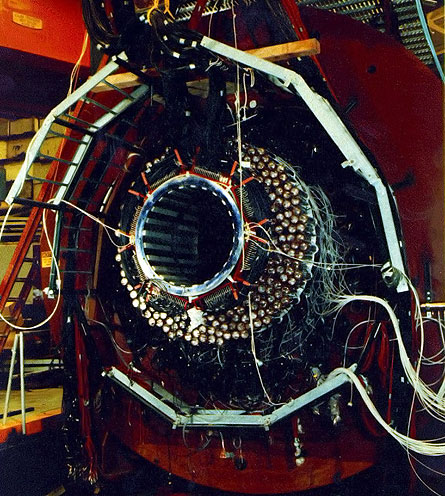Call off the guard dogs. No one — yet — has to worry about researchers drastically tinkering with the standard model of particle physics, the wildly successful theory that describes how elementary particles interact and form the building blocks of matter.

But in sifting through the ashes of a short-lived subatomic particle called the kaon, physicists have found new hints that the theory might one day need to be modified.
Ideas for a possible alteration range from a new type of force to a new family of elementary particles.
For now, the standard model is safe, concludes a large, international research team in an article posted online August 19. That’s because the findings, based on the discovery and analysis of an extraordinarily rare mode of disintegration of the kaon, are not statistically significant, notes Douglas Bryman of the University of British Columbia in Vancouver, a member of the team.
There are many ways that a kaon, which lasts for only 12 billionths of a second, can decay into other particles. In one of the rarest modes, the kaon transforms into three other particles: a positively charged pion, which is observed, and an undetectable pair that is a neutrino and its antiparticle partner, the antineutrino.
According to the standard model, a kaon will decay in this way only one out of every 12 billion disintegrations. But researchers analyzing a series of accelerator experiments that took place at the Brookhaven National Laboratory in Upton, N.Y., from 1989 to 2002 have now found that the kaon died in this particular manner twice as frequently as the standard model predicts, Bryman and his colleagues say.
The number of new events observed is not high enough to cause trouble for the standard model, Bryman and his colleagues note in the article, which appeared the same day as a scheduled presentation on the findings at Brookhaven by study member and Brookhaven physicist David Jaffe.
To catch the fleeting events and identify the rare decay, the scientists built a house-sized particle detector that can examine 1.6 million kaon decays every second. Physicists have since mined the recorded data to search for the most promising events and analyzed them in exquisite detail, leading to the earlier discovery of four of the rare kaon decays.
The newest analysis focuses on events that produce lower-energy pions, which are more difficult to pick out because of background noise. That is also why the three newly observed events have weaker statistical significance than three of the four previously known events, says team member Laurence Littenberg of Brookhaven.
Physicists had hoped to gather five times as much data, but budget cuts led the Department of Energy to abruptly end the Brookhaven experiment in 2002, Littenberg says. However, if the trend of finding a higher decay rate in this rare mode continues with other experiments expected to start at the Japan Proton Accelerator Research Complex in Tokai-mura — researchers are shipping their Brookhaven kaon detector there — as well as at CERN in Geneva, the standard model could be in for a revision.
Experimental particle physicist Jonathan Rosner of the University of Chicago says he sees “no need at present for invoking new physics.” However, he and other researchers acknowledge that the standard model fails to explain several mysteries, including why the universe has much more matter than antimatter and why the elementary particles have the masses they do. Says Rosner: “A crack in the standard model will have to appear somewhere eventually and rare kaon decays are as good a place as any to pursue this possibility.”
In the rare decay mode studied in the experiment, a strange quark inside the kaon is transformed into a down quark (inside the pion). Such a reaction can only occur if very heavy messenger particles — particles that convey the force known as the weak interaction — are exchanged. The complexity of the reaction aggressively tests the standard model. “This is why this process is so rare and is also the reason why it is so interesting: it is a special window on physics beyond the standard model,” says theorist Gino Isidori of the Laboratori Nazionali di Frascati in Rome.
Isidori says he favors a modification of the standard model known as supersymmetry, which predicts a doubling of the number of all known elementary particles. For instance, each “standard” quark would have a heavier, supersymmetric partner. The exchange of these heavy particles could explain the higher rate of the rare process observed at Brookhaven, he says.
If this explanation is correct, researchers should observe some of these particles at the Large Hadron Collider, scheduled to open at CERN this fall, says Isidori (SN: 7/19/08, p.16).







